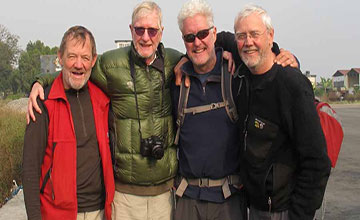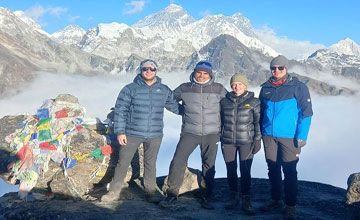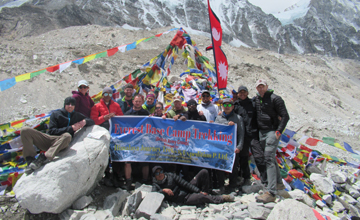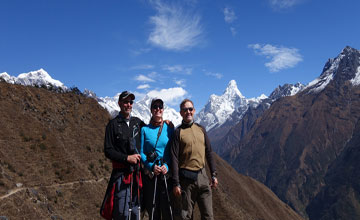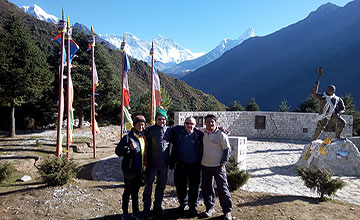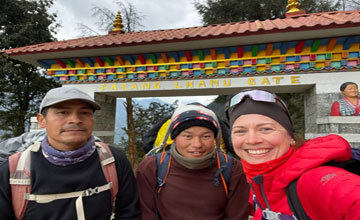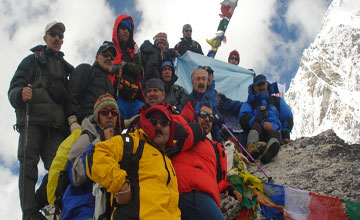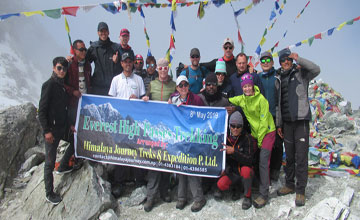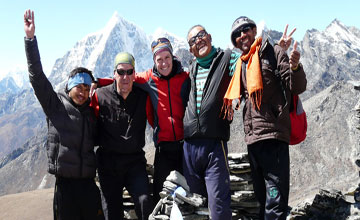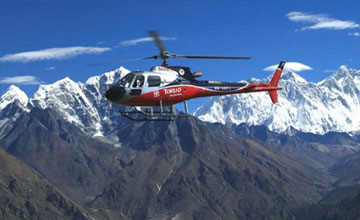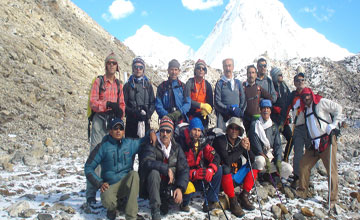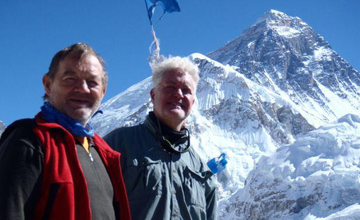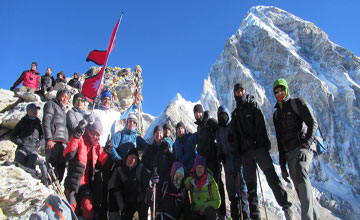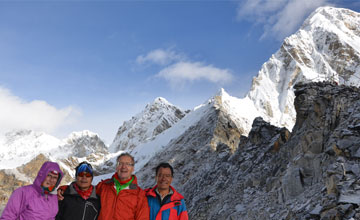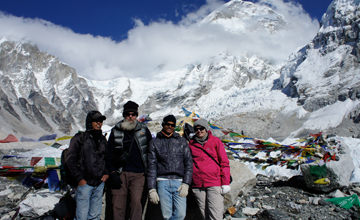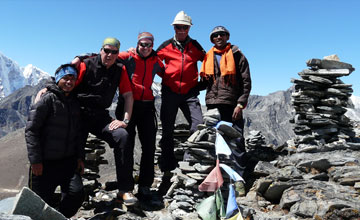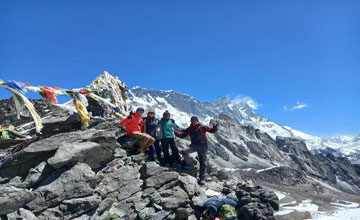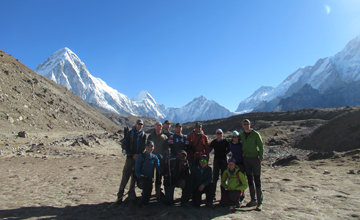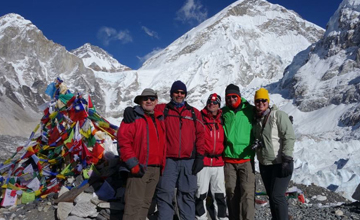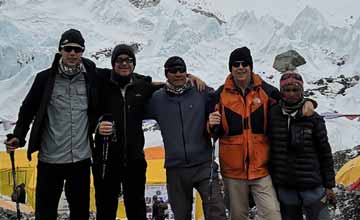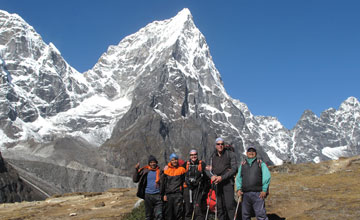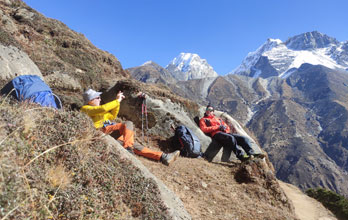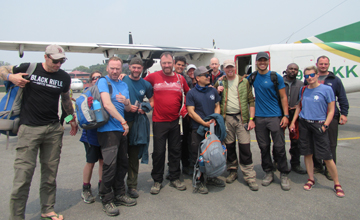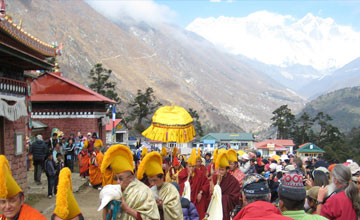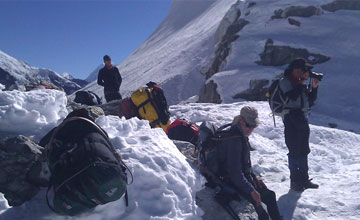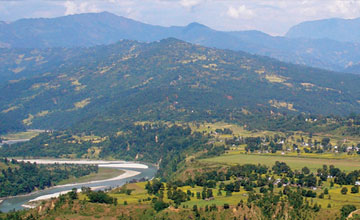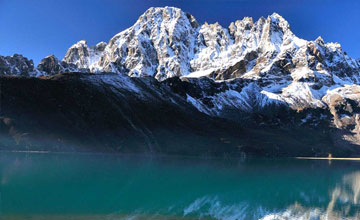.jpg)
Everest three high Passes trek
The Everest three high Passes trek is an adventurous and challenging trekking route in the Everest region of Nepal .The Anticlockwise Everest Three high passes trekking involves crossing three high passes trekking in Nepal: Kongma La Pass (5,535m/18,159ft), Cho La Pass (5,420m/17,782ft), and Renjo La Pass (5,360m/17,585ft), each offering breathtaking views of the Himalayas.
Everest 3 high passes trek designed for adventure trekkers who are seeking a more strenuous and remote journey compared to the classic Everest Base Camp trek. Embark on an exciting anticlockwise Everest Three Passes Trek and get the better Himalayan views of whole Everest trekking trails as well as chances to see Mount Everest from different angle.
Everest three high pass trek offer best mountain vistas of Khumbu trekking trails including top of the world Mount Everest 8848m, Mount Lhotse 8516m, Mount Makalu 8463m, Mount Cho Oyu 8201m and more then two dozen mountain peaks of the Everest region. If you are looking for Three high passes trek in Nepal this is one of the best choice and summit higher than the Alps in Europe, USA and rest of the countries.
Everest high passes trekking consist of many travelers bucket list like a classic Everest base camp trekking route to explore the longest Himalayan Ngozumpa glacier (35 km/ 22 miles) , Mount Everest base camp 5363 m, Kala patthar 5545 m, Gokyo Ri 5360 m and Chhukung Ri 5500 m .
Comparing the clockwise Everest three high passes treks anticlockwise Everest three high passes trek slightly easier option however trek route follow the same route. If you wish to Anti clockwise Everest 3 high passes trekking just click for depth details.
17 days Everest three passes trekking trip start from Lukla Hillary airport after 35 minutes flight from Kathmandu or 15 minutes flight from Ramechhap, Manthali. Himalaya Journey Trekking guide lead your adventure through alpine region with crossing 7 suspensions bridges from Lukla to Namche Bazzar.
One more day acclimatization day at Namche Bazaar as stand point of the altitude sickness and during this day will take you Everest view hotel ( highest located 5 star hotel in Everest region) for superb Himalayan views of Mount Ama Dabam, Thamserku, Nuptse, Khumbila , Island peak, Twache peak and other mountains of Everest region trekking.
Trek continue ascend through Tengboche, Dingboche , Chhukung Ri attempt first Kong Ma la pass and than follow the regular Everest base camp Kala patthar trek route. You will have unbelievable experience hike to Everest base camp and next morning take to Kala patthar ( Black rock ) which is the nearest view point of Mount Everest , Lhotse , Nuptse and Pumori.
Trail continue back up to Louche same path and straight way to Dzong la. You need to start early morning to cross the cho la pass 5420 m and heading the Gokyo valley. Hike to Gokyo Ri is another attraction point of this trekking and visible sloppy mount Everest faces.
Gokyo Lake is beautiful Himalayan lake in Nepal and travelers may join for fifth lake trip while ascend from the Thangnak to Gokyo . The trail continue ascend up to the Renjo la pass and enter to the Thame village , Namche Bazaar , trail rejoins the EBC trekking trails and eventually reach at Lukla then by flight back to Kathmandu.
Everest three high passes trek Major Highlights
The Everest Three High Passes Trek is renowned for its stunning landscapes, challenging mountain passes, and cultural encounters. Here are some of the major highlights of this Everest three high passes trek:
The Scenic Flight to Lukla: The journey typically begins with a thrilling flight from Kathmandu to Lukla, offering panoramic views of the Himalayas and providing a unique perspective of the rugged terrain.
Namche Bazaar: This bustling Sherpa town serves as the gateway to the Everest region and is a vibrant hub of Sherpa culture and commerce. Trekkers spend time acclimatizing here and exploring its markets, monasteries, and scenic viewpoints.
Tengboche Monastery: Situated at an elevation of 3,867 meters, Tengboche Monastery is one of the most important monasteries in the region and offers stunning views of Everest, Ama Dablam, and other peaks.
Kongma La Pass (5,535m/18,159ft): Crossing the first of the three high passes, Kongma La Pass, offers breathtaking views of the surrounding Himalayan peaks, including Everest, Lhotse, and Makalu.
Everest Base Camp trek route: Trekking to Everest Base Camp allows trekkers to stand in the shadow of the world's highest mountain and witness the iconic Khumbu Icefall. The base camp is a bustling hub of climbers and offers spectacular views of Everest.
Kala Patthar: A viewpoint located near Everest Base Camp, Kala Patthar offers one of the best panoramic views of Mount Everest, along with neighboring peaks such as Nuptse and Pumori. It's a popular spot for sunrise or sunset views.
Cho La Pass (5,420m/17,782ft): Crossing Cho La Pass involves navigating through a glacier and steep rocky terrain. The pass offers stunning views of the surrounding peaks, including Ama Dablam and Cholatse.
The Gokyo Lakes: The Gokyo region is home to a series of beautiful turquoise lakes nestled amidst towering mountains. Trekkers have the opportunity to explore these serene lakes and hike up Gokyo Ri for panoramic views of the Everest region.
Renjo La Pass (5,360m/17,585ft): Crossing Renjo La Pass offers sweeping views of Everest, Cho Oyu, and other peaks. The pass is known for its stunning Himalayan vistas and is a highlight of the trek.
Sherpa Culture and Hospitality: Throughout the trek, trekkers have the chance to interact with the Sherpa people, renowned for their hospitality and rich cultural heritage. Visiting monasteries, Sherpa villages, and experiencing local customs adds depth to the trekking experience.
Sagarmatha National Park: The trek passes through Sagarmatha National Park, a UNESCO World Heritage Site known for its diverse flora and fauna, including rhododendron forests, Himalayan wildlife, and rare bird species.
Everest three high passes trek duration
The Everest Three High Passes Trek duration usually takes about 17 to 20 days to complete, depending on the route and speed of the trek. Three high passes trekking in Everest region covered 100 to 120 miles (160 to 193 kilometers) round trip from Lukla Hillary airport.
Anticlockwise Everest three high passes trek difficulty level
The Everest Three High Passes Trek is considered one of the most challenging trekking routes in the Everest region of Nepal. It's suitable for experienced trekkers who are physically fit, mentally prepared, and have prior high-altitude trekking experience. Here are some factors contributing to Everest 3 high passes trek difficulty level:
High Altitude: The trek involves crossing three high mountain passes - Kongma La Pass (5,535m/18,159ft), Cho La Pass (5,420m/17,782ft), and Renjo La Pass (5,360m/17,585ft). Trekking at such high altitudes presents challenges related to altitude sickness, including shortness of breath, fatigue, headaches, and nausea. Proper acclimatization is crucial to minimize the risk of altitude-related problems.
Technical Terrain: The trek includes sections of technical terrain, particularly while crossing the high passes. Trekkers may encounter steep ascents, rocky trails, icy slopes, and moraines. Some sections may require the use of hands for balance and stability.
Weather Conditions: Weather conditions in the Everest trekking trails can be unpredictable and harsh, particularly at high altitudes. Trekkers may encounter cold temperatures, high winds, snowfall, and occasional storms, which can affect visibility and trail conditions.
Remote and Isolated Environment: The Everest three high pass trekking route passes through remote and isolated areas with limited access to medical facilities and basic amenities. Trekkers need to be self-sufficient and prepared to deal with unexpected situations.
Physical Fitness: The Anticlockwise Everest 3 high passes trek required a good level of physical fitness, including cardiovascular endurance, strength, and stamina. Trekkers should engage in pre-trek training to prepare their bodies for the demands of hiking at high altitudes.
Overall, while the Everest Three High Passes Trek is challenging, it offers incredible rewards in terms of stunning Himalayan scenery, cultural experiences, and personal achievement for those who undertake the journey. Proper preparation, including physical training, acclimatization, and selecting a reputable trekking company, is essential for a successful and enjoyable trekking experience.
The best season for Everest three high passes trekking
The best time for the Everest Three High Passes Trek is during the pre-monsoon (spring) and post-monsoon (autumn/fall) seasons, which offer favorable weather conditions and clearer skies for trekking in the Everest region. The recommended times to undertake the trek are:
Spring Season (March to May):
March: The tail end of winter, with colder temperatures but less crowded trails.
April to May: Ideal trekking months with warmer temperatures, blooming rhododendrons, and clear skies. May can be slightly busier due to the spring climbing season.
Autumn/Fall Season (September to November):
September: The end of the monsoon season, with occasional rain but generally clear skies and lush landscapes.
October to November: The most popular and busiest trekking season, characterized by mild temperatures, clear skies, and stunning views. October, in particular, is considered the best month for trekking in Nepal.
During these seasons, the weather is generally stable, with minimal precipitation, clear visibility, and comfortable temperatures for trekking. The trails are well-defined, and the mountain views are spectacular, making for an unforgettable trekking experience.
It's important to note that while the spring and autumn seasons are optimal for trekking in the Everest region, they can also be relatively crowded, especially along popular routes like the Everest Base Camp trail. If you prefer quieter trails, you may consider trekking during the shoulder seasons (late February to early March or late November to early December), although weather conditions may be slightly less predictable.
Avoid trekking during the monsoon season (June to August) due to heavy rainfall, cloudy skies, and leech-infested trails, which can make trekking challenging and potentially dangerous. Similarly, winter (December to February) brings cold temperatures, reduced visibility, and the risk of snowfall, particularly at higher elevations, making it less suitable for trekking.
Ultimately, the best time for the Everest Three High Passes Treks depends on your preferences, trekking experience, and availability. Be sure to check weather forecasts and trail conditions before embarking on your trek, and consider consulting with local trekking agencies for up-to-date information and recommendations.
Everest three high passes trek cost
The cost of the Everest Three High Passes Trek can vary depending on several factors, including the duration of the trek, the level of service provided by the local Nepal trekking agency, the season of travel, the number of trekkers in the group, and additional expenses such as permits, accommodations, meals, guide and porter services, equipment rental, and transportation. Here's a breakdown of the typical costs associated with the trek:
Everest three passes trekking Permits: Trekkers need to obtain permits to enter the Sagarmatha National Park and the Khumbu Pasang Lhamu Rural Municipality. The Sagarmatha National Park entry permit costs around USD 30 per person, and the Khumbu Pasang Lhamu Rural Municipality entrance fee is approximately USD 20 per person. These permits are usually arranged by the Local Nepal trekking companies.
Guide and Porter Services: Hiring a Nepal trekking guide and porter is highly recommended for safety and assistance during the trek. The cost of guide and porter services can vary but typically ranges from USD 30 to USD 35 per day for a guide and USD 20 to USD 25 per day for a porter. This cost usually includes their wages, accommodation, meals, and insurance.
Accommodations: Accommodation options along the trekking route range from basic teahouses to more comfortable lodges in popular villages. The cost of accommodation varies depending on the standard of facilities provided. On average, expect to pay around USD 10 to USD 15 per night for a basic teahouse room, including meals.
Meals: Most teahouses and lodges offer meals such as dal bhat (rice and lentils), noodles, soups, and tea/coffee. The cost of meals varies depending on the menu items and location but typically ranges from USD 10 to USD 15 per meal.
Transportation: The cost of transportation to and from the trekking starting point (usually Lukla) from Kathmandu via domestic flights is an additional expense. The round-trip flight from Kathmandu to Lukla costs approximately USD 425 per person, depending on the airline, season, and availability.
Miscellaneous Expenses: Other miscellaneous expenses may include bottled water, snacks, hot showers, Wi-Fi access, charging electronic devices, tips for guides and porters, and personal purchases.
Overall, the total cost of the Everest Three High Passes Trek can range from USD 1,875 to USD 3,500 per person for a standard 20 to 21-days Everest three high passes trekking tour, depending on the above factors. It's essential to plan and budget accordingly, taking into account any additional expenses and contingencies. Additionally, booking through a reputable Nepal trekking agents ensures a smoother and more organized experience, as they can assist with logistics, permits, and other arrangements.
Everest Three high passes trek itinerary:
Day 01: Arrival in Kathmandu (1334m), transfer Hotel, Everest three high passes trek briefing with officially arrangments. overnight at kathmandu.
Day 02: Flight to Lukla Hillary airport . Lukla trek to Phakding. Distance: 8 km/ 4.9 miles. Altitude: 2840 meters – 2610 meters. Walking 4 hours.
Day 03: Phakding trek to Namche Bazaar. Distance: 11 km/ 6.8 miles. Altitude: 2610 meters – 3440 meters. Walking 6/7 hours. Night Stay at Mountain Lodge.
Day 04: Acclimatization day at Namche Bazaar. You can do the day trip.
Option I: Day trip to Shyangboche/ Everest View Hotel and back to Namche Bazaar. Distance: 4.6 km/ 2.8 miles. Walking 2/ 3 hours. Night Stay at Mountain Lodge.
Option II: Day trip to Shyangboche/ Everest View Hotel (3440 meters) to Kumjung Village (3780 meters) and back to Namche Bazaar. Distance: 9 km/ 5.5 miles. Walking 5/ 6 hours.
Day 05: Namche Bazaar trek to Tengboche. Distance: 11 km/ 6.8 miles. Altitude: 3440 meters – 3860 meters. Walking 5/6 hours.
Day 06: Tengboche trek to Dingboche. Distance: 10.5 km/ 6.5 miles. Altitude: 3860 meters – 4410 meters. Walking 5/6 hours.
Day 07: Dingboche trek to Chhukung. Distance: 5 km/ 3.1 miles. Altitude: 4410 meters – 4730 meters. Walking 2:30/3 hours.
After lunch HJT Guide take to you Chhukung Ri 5500 meter for superb Himalayan views of Mt. Everest 8848m, Mt. Lhotse 8516m, Mt. Makalu 8463m and other mountain peak of Everest treks route.
Day 08: Chhukung trek to Kongma La Pass to Lobuche. Distance: 11 km/ 6.8 miles. Altitude: 4730 meters – 5535 meters (Kongma La Pass) – 4910 meters. Walking 8/9 hours.
Day 09: Lobuche trek Gorakshep and after lunch trek to Everest Base Camp then back to Gorak Shep. Distance: 12 km/ 7.4 miles. Altitude: 4910 meters – 5364 meters (Mount Everest Base Camp) – 5180 meters. Walking 7/8 hours.
Day 10: Early in the morning hike to Kalapatthar then trek down to Dzongla. Distance: 16 km/ 9.9 miles. Altitude: 5140 meters – 5545 meters (Kalapathar) – 4830 meters. Walking 8 hours.
Day 11: Dzongla via Cho La Pass 5420 m to Thangnak. Distance: 9.38 km/ 5.8 miles. Altitude: 4830 meters – 5420 meters (Cho La Pass) – 4750 meters. Walking 8/9 hours.
Day 12: Trek from Thangnak to Gokyo Lake. Distance: 4.4 km/ 2.7 miles. Altitude: 4700 meters – 4790 meters. Walking 3:45/4 hours.
Day 13: Excursion near Gokyo Lake.
Option I: Hike up to Gokyo Ri (5360 meters) and back to Gokyo Lake (4790 meters). Distance: 4 km/ 2.4 miles. Walking 3/4 hours.
Option II: Hike to 4th Lake (4870 meters) and 5th Lake (4990 meters) and back to Gokyo Lake (4790 meters). Distance: 14 km/ 8.6 miles. Walking 6/7 hours.
Day 14: Gokyo via Renjo La Pass trek to Marlung. Distance: 13 km/ 8.07 miles. Altitude: 4790 meters – 5360 meters (Renjo La Pass) – 4210 meters. Walking 7/7:30 hrs.
Day 15: Marlung via Thame trek to Namche Bazaar. Distance: 18 km/ 11.1 miles. Altitude: 4210 meters – 3820 meters (Thame) – 3440 meters. Walking 7/8 hours. O/n at Tea House.
Day 16: Namche Bazaar trek to Lukla. Distance: 19 km/ 11.8 miles. Altitude: 3440 meters – 2840 meters. Walking 7/8 hours.
Day 17: After breakfast, Lukla Kathmandu flight or lukla Ramechhap flight, transfer to hotel. overnight at Kathmandu.
Day 18: After breakfast, HJT tour guide will take to for historical monuments sightseeing in kathmandu valley such as Boudhhanath : visit Bodhnath Stupa, one of the biggest Buddhist shrines in the world, where we observe Buddhist monks in prayer in the monasteries surrounding the stupa than visit Pashupatinath: the most famous Hindu temple in the country, located on the banks of the holy Bagmati River. Here you see Hindu holy men (sadhus) meditating, pilgrims bathing and occasionally funeral pyres burning on the ghats. Kathmandu durbar square: you will enjoy with different Hindus Temple , Goddes Kumari, legend of kathmadu valley etc and in the evening farewell dinner in Nepalese Restaurant, overnight at kathmandu in Hotel.
Day 19: After breakfast, relaxing or shopping with own activities then Himalaya Journey Trekking representative will drip to you Kathmandu International airport forward journeys or if have time for Nepal will arrange accordingly such as Chitwan jungle safari tour, Lumbini Pokhara Nagarkot tour , Rafting etc
Everest Three high passes trek cost:
[email protected] , [email protected]
Service includes:-
- Airport pick up and transfer to hotel.
- Three night accommodation in Kathmandu on BB basis ( 3 star category hotel) on twin sharing as mentioned in itinerary
- An experienced, helpful and friendly Government license holder trekking Guide.
- Domestic airport pick up and drop by private car/van/ Minibus / Bus to catch Kathmandu Lukla Kathmandu Flight .
- Kathmandu to Lukla /Lukla to Kathmandu both way flight ticket (both way flight cost per person $ 380)
- Trekking guide both way flgiht ticket as mentioned in itinerary
- Trekking porter /sherpa who will carry your bag pack during the trekking. ( two person get one trekking porters who will carry maximum 25-30 kg as per rule and regulation of Nepal workers Union )
- Three time meal during the trekking Breakfast, Lunch & Dinner.
- Desert /fruit after having diner as company provide
- Trekker's Information Management system (TIMS)
- Sagarmatha National park permit
- Khumbu pasang lamu rural municipality entry permit as mentioned in itinerary
- Kathmandu domestic airport pick up and trasfer to hotel as mentioned in itinerary
- Kathmandu valley guided sightseeing tour as mentioned in itinerary
- Kathmandu valley sightseeing tour with private vehicle
- All program as mentioned in itinerary
- Overland transportation
- Trekking guide both way flight ticket
- Insurance for Nepalese staff. ( Trekking guide, and porters)
- Guide and porter fares and taxes.Government
- Tax and office service charge.
- Airport drop
Service Excludes:-
- Lunch & Dinner during Kathmandu stay
- International flight ticket
- Nepal entry visa fee US$ 40 (duration 60 days from date of issue)- you may easily issue the visa upon your arrival at Tribhuwan International Airport - Kathmandu.
- Disembarkation Airport Tax in Nepal - approx. US$ 24. al equipments
- High risk medical insurance
- Entrance fees while sightseeing tour in Kathmandu valley.
- Alcoholic beverage and telephone calls
- Hot drinks, Soft drinks such as cola, mineral water
- Nepal Visa Fee
- Emergency rescue evacuation if needed
- Purely personal nature expenses
- Tipping /Tips(Tipping is Expected).
Everest three passes trek Equipments
- Trekking Bag pack.
- Trekking day bag.( Small handbag)
- Trekking shoes.
- Sports shoes or sandal.
- Trekking stick.
- Trekking Hat, cat
- Trekking woollen cap.
- Trekking jacket Gore tax/ flees jacket.
- Pullover or warm sweeter.
- Raincoat.
- 4/5 pairs of good qualities shock .
- Hand gloves.
- 2/3 pairs of Trekking trousers
- 3/4 pairs of Trekking shirts .
- 3/4 pairs of Underwear
- Eye glass
- Water bottle.
- Sleeping bag.
- Flash or Torch light.
- Camera and batteries.
- Sun cream.
Photo gallery
Please click on thumbnail image to have larger view.
Useful Information:
The Everest three high Passes trek is an adventurous and challenging trekking route in the Everest region of Nepal .The Anticlockwise Everest Three high passes trekking involves crossing three high mountain passes trekking in Nepal: Kongma La Pass (5,535m/18,159ft), Cho La Pass (5,420m/17,782ft), and Renjo La Pass (5,360m/17,585ft), each offering breathtaking views of the Himalayas.
Everest 3 high passes trek designed for adventure trekkers who are seeking a more strenuous and remote journey compared to the classic Everest Base Camp trek. Embark on an exciting anticlockwise Everest Three Passes Trek and get the better Himalayan views of whole Everest trekking trails as well as chances to see Mount Everest from different angle.


